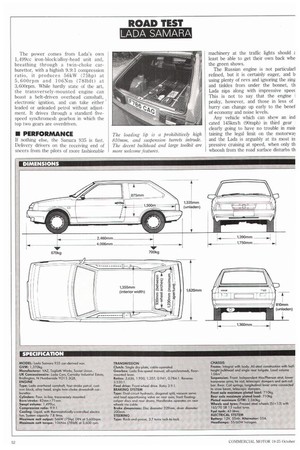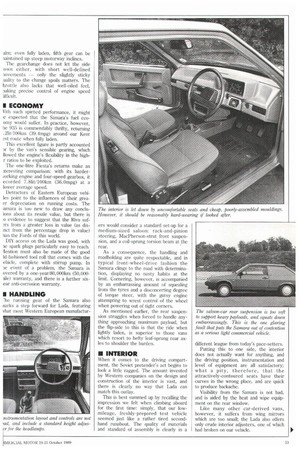ROAD TEST LADA SAMARA
Page 56

Page 57

If you've noticed an error in this article please click here to report it so we can fix it.
The power comes from Lada's own 1,499cc iron-block/alloy-head unit and, breathing through a twin-choke carburettor, with a highish 9.9:1 compression ratio, it produces 56kW (75hp) at 5, 60Orpm and 106Nm (781bft) at 3,600rpm. While hardly state of the art, the transversely-mounted engine can boast a belt-driven overhead camshaft, electronic ignition, and can take either ' leaded or unleaded petrol without adjustment. It drives through a standard fivespeed synchromesh gearbox in which the top two gears are overdriven.
If nothing else, the Samara 935 is fast. Delivery drivers on the receiving end of sneers from the pilots of more fashionable
The loading iip is a prohibitively high 810mm, and suspension turrets intrude. The decent bulkhead and large toolkit are more welcome features.
machinery at the traffic lights should least be able to get their own back whe the green shows.
The Russian engine is not particular] refined, but it is certainly eager, and b using plenty of revs and ignoring the zing and tinkles from under the bonnet, th Lada nips along with impressive speec This is not to say that the engine peaky, however, and those in less of hurry can change up early to the benef of economy and noise levels.
Any vehicle which can show an ind cated 145km/h (90mph) in third gear clearly going to have no trouble in malt timing the legal limit on the motorwal and the Lada is arguably at its most in pressive cruising at speed, when only th whoosh from the road surface disturbs th alm; even fully laden, fifth gear can be aaintained up steep motorway inclines.
The gearchange does not let the side lown either, with short well-defined aovements — only the slightly sticky ivality to the change spoils matters. The hrottle also lacks that well-oiled feel, :taking precise control of engine speed Lifficult.
Vith such spirited performance, it might e expected that the Samara's fuel ecoorrty would suffer. In practice, however, he 935 is commendably thrifty, returning .21itil00km (39.4mpg) around our Kent est route when fully laden.
This excellent figure is partly accounted Dr by the van's sensible gearing, which llowed the engine's flexibility in the highT ratios to be exploited.
The one-litre Fiesta's returns make an tteresting comparison: with its harder forking engine and four-speed gearbox, it ecorded 7.81it/100km (36.0mpg) at a lower average speed.
Detractors of Eastern European vehiles point to the influences of their grea er depreciation on running costs. The amara is too new to draw any concluions about its resale value, but there is o evidence to suggest that the Riva sufers from a greater loss in value (as disnet from the percentage drop in value) an the Fords of this world.
DIY access on the Lada was good, with :le spark plugs particularly easy to reach.
4ention must also be made of the good Id-fashioned tool roll that comes with the ehicle, complete with stirrup pump. In ae event of a problem, the Samara is overed by a one-year/80,000km (50,000tile) warranty, and there is a further sixear anti-corrosion warranty.
.'he running gear of the Samara also narks a step forward for Lada, featuring vhat most Western European manufactur
ers would consider a standard set-up for a medium-sized saloon: rack-and-pinion steering, MacPherson-strut front suspension, and a coil-sprung torsion beam at.t he rear.
As a consequence, the handling and roadholding are quite respectable, and in typical front-wheel-drive fashion the Satnara clings to the road with determination, displaying no nasty habits at the limit. Cornering, however, is accompanied by an embarrassing amount of squealing from the tyres and a disconcerting degree of torque steer, with the gutsy engine attempting to wrest control of the wheel when powering out of tight corners.
As mentioned earlier, the rear suspension struggles when forced to handle anything approaching maximum payload, but the flip-side to this is that the ride when lightly laden, is superior to those vans which resort to hefty leaf-sprung rear axles to shoulder the burden.
When it comes to the driving compartment, the Soviet pretender's act begins to look a little ragged. The amount invested by Western companies on the design and construction of the interior is vast, and there is clearly no way that Lada can match this outlay.
This is best summed up by recalling the impression we felt when climbing aboard for the first time: simply, that our lowmileage, freshly-prepared test vehicle seemed just like a rather tired secondhand runabout. The quality of materials and standard of assembly is clearly in a The saloon-car rear suspension is too soft to support heavy payloads, and squats down embarrassingly. This is the one glaring fault that puts the Samara out of contention as a serious light commercial vehicle.
different league from today's pace-setters.
Putting this to one side, the interior does not actually want for anything, and the driving position, instrumentation and level of equipment are all satisfactory; what a pity, therefore, that the attractively-contoured scats have their curves in the wrong place, and are quick to produce backache.
Visibility from the Samara is not bad, and is aided by the heat and wipe equipment on the rear window.
Like many other car-derived vans, however, it suffers from wing mirrors which are too small; the Lada also offers only crude interior adjusters, one of which had broken on our vehicle.






























































































































































